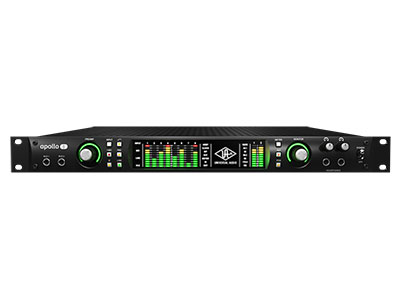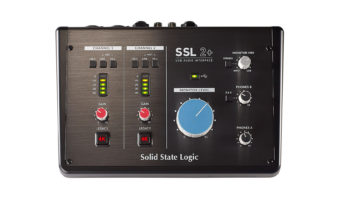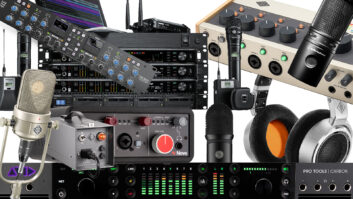
Universal Audio is synonymous with pioneering audio quality on the highest level. We’re all familiar with the company’s extensive hardware outboard range and the groundbreaking work Universal Audio has done on the DSP and plug-in side of our industry. The Apollo 8p is the latest in the company’s I/O range, breaking new ground while maintaining the quality users now expect.
Onboard Apollo
The Apollo 8p sets itself apart from other Univeral Audio interfaces by re-focusing the I/O setup. The original four mic inputs have been upped to eight digitally controlled Unison mic preamps.
Inputs are handled by eight combo XLR/TRS sockets on the back, and a pair of hi-Z unbalanced TS JFET inputs on the front panel. Digital I/O includes eight channels of ADAT/SMUX Optical Lightpipe, which can be switched to S/PDIF. The two Thunderbolt 2 ports allow for daisy-chaining third-party devices and also allow for four Apollo units and six UAD devices to be cascaded on a Mac.
The output section has undergone some change, too. The unit offers analog outputs, two monitor outs, and, on the front, two headphone outs—all on balanced TRS jacks. Word clock In and Out BNCs complete the back of the unit. The processing under the hood features the UAD-2 Quad Core DSP on four SHARC processors. UA has also improved dramatically on the original design of the original Apollo A-D/D-A conversion algorithm, resulting in an improved dynamic range (3 dB) and lower Total Harmonic Distortion figure.
Front and Center
The 8p front panel has that classic Universal Audio look and feel. In addition to the dual hi-Z inputs and the two, independently controlled headphone sockets, there are the mic preamp controls and the monitor section. The preamp encoder sets the gain for each of the eight mic pre’s. You can scroll through the channels by pressing down on the encoder knob. Inputs can be switched between mic and line with a single button press. Five more backlit buttons give the user access to +48-volt Phantom power, phase reverse, a second-order coincident-pole highpass filter with a cutoff frequency of 75 Hz (12 dB per octave), a 20dB pad, and a link function to pair up adjacent channels.
The metering comprises eight 10-segment LEDs that monitor either input or output. Selected channels are illuminated, and the panel also displays mic/line/hi-Z status, Thunderbolt connection, and whether the unit is clocking internally or is being fed external clock. Next to the cool and brightly lit UA logo is info on sample rate, while another pair of 10-segment LED meters display the signal peak output levels of the D/A converters, independent from the monitor level control.
The monitor section comprises the Monitor Level encoder and three switches that allow In/Out metering switching, an ALT monitor switch that toggles between the main monitor outs, and the ALT1 outputs, which are fed by the 1 & 2 line outs. Finally, a very handy assignable soft Function switch can be customized. The FCN switch can either engage an alternate set of monitor outputs fed to outs 3 & 4; it can be a Mono switch, summing the left and right channels; or the user can set it as a Dim switch to reduce monitor output by a desired amount of decibels.
Apollo’s Softer Side
You can pretty much do everything you need from the front panel of the Apollo 8p, but it’s the revamped Console Version 2 software that gets you under the hood. This is where you can get to all the powerful routing features that will make this interface perform exactly how you want it to. The main function of Console 2.0 is to offer hardware control for the input monitoring and real-time UAD processing, and it’s also where you access the amazing Unison plug-ins. Unison is UAD’s breakthrough way of inserting its classic preamps right at the start of the signal chain. This technology allows the user to track with the sound and behavior of the legendary Universal Audio 610 A and B, API Vision, Neve 88RS and 1073, a handful of guitar pedals, and most recently the classic Manley VOXBOX. And all of these flavors come without any noticeable latency.
If you’re not convinced yet, here’s the deal maker: the Console Recall plug-in. This plug stores all the Apollo’s Console settings and routing used for the session. Simply load the plug-in into your session, hit the sync button and all the information will be stored with your DAW session.
Lights, Camera, Action!
I got to use the Apollo on a few mix and simple single-track recording sessions at RAK Studios in London. The first thing that hit me was the vast improvement in the overall sound compared to its siblings—so much so that I really wanted to see how it performed in a high-pressure location setup.
We were running a multiple-camera set up with two people demonstrating at a counter. The microphones have to be out of shot of several cameras, so they are never in an optimal situation and therefore require a substantial amount of gain. This results in fairly noisy recordings because of the preamp. In addition to the room mics, we also have two lapel mics, one going to my rig and another one going straight to the wide-angle camera for sync purposes.
I brought my usual interface just in case. It had already been set up with this particular rig and I wanted a fallback scenario. Well, that was not necessary because Apollo 8p wiped the floor with the previous systems. Setup couldn’t have been more straightforward. Just load the software, downloaded from the UAD site, plug in the Thunderbolt, and voila—every input shows up on Console 2.0 and the DAW. You then have the choice to monitor via the DAW or through the Console software, and you’re ready to go.
These days everybody tends to show up with his or her own pair of headphones, and of course there’s the constant impedance mismatch. The two headphone volume-controlled outputs dispense with the need for splitters, and it gave me the option to deliver a separate output and mix tailored to the producer’s needs without affecting what I was monitoring.
Having test driven and been convinced by the Unison pre’s, I wanted to hear how the interface’s preamps performed in this particular situation. The material comprises a lot of dialog between two very different voices and a good dose of dynamically varied noises.
The first thing that hit me was the absolute clarity of the preamps. Even with the gain extremely high on certain channels, I could not make out any of that fizzy self-noise you get on certain interfaces. As the session is time sensitive, there are no re-takes, and some of the louder impacts can’t be anticipated, so occasionally there will be a dreaded red-light peak on the input. This is another area where the Apollo’s preamps rescued the day. Even the odd clip still sounded pure and clear, without discernible distortion. One more cool feature to be aware of is the ability to bypass the 8p’s gain control and fix the Line In and Outs, turning the unit into a straight I/O box.
In a Nutshell
The Apollo 8p is a superb interface. If you’re looking for a box that will give you crisp and clean microphone preamps with the ability to turn them into classic and vintage sounding ones, look no further. Eight preamps, multichannel outs, super low latency, onboard processing and the best of the analog world combined with ahead-of-the-curve digital technology make Universal Audio’s Apollo 8p a true winner. Oh, and if you haven’t tried those UAD plug-ins yet, do so today. They’ll blow your mind!
PRODUCT SUMMARY
COMPANY: Universal Audio
PRODUCT: Apollo 8p
WEBSITE: www.uaudio.com
PRICE: $2,999
PROS: Ultra-clean preamps, low latency, Unison preamp modeling, dual headphone outs
CONS: No separate line inputs on the back. FireWire protocol has been removed, so it only works on Thunderbolt-enabled workstations.
TRY THIS
Using the same mic on each channel, insert a different Unison preamp on the Console strips and record your source to compare sounds and character. If you can get hold of the hardware versions of the preamps, use similar settings from the same source and compare them to the Unison recording you made. You will be amazed.
Wes Maebe is a UK-based recording, mixing, mastering, and live sound engineer.







